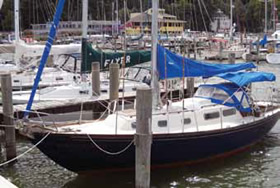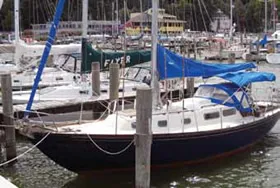We now have a boat-an Allied Seabreeze 35 sloop, hull number 23, from 1965-and overall, its a well-kept and sea-kindly boat. Winter is coming, and a winter cover seems in order. The conduit-frame-and-tarp that you published (www.practical-sailor.com/marine/do_it_yourself_winter_frame-10593-1.html) is an option, but a fitted canvas (Sunbrella or better) cover is another, which will perhaps pay for itself in about three seasons. What is your view on this?
Alan Hyde
Wolf Hound, Allied 35
Dover, Mich.
This is a big topic worthy of a larger article. For a snapshot view of the custom-cover options, we talked to Jim Welinski, co-owner of the family-run Shipshape Canvas shop (www.shipshapecanvas.com) in Duluth, Minn., where stored boats face some of the countrys harshest winters.

Most custom covers today are frameless, making them easier to stow and install than the excellent DIY frame-cover described on our website. In either case, a reusable cover will save money in the long haul. A robust, frameless winter cover for a Catalina 30 costs about $1,800 and can last eight to 15 years (with a re-stitching after about eight years), depending on how you treat it. Lighter-weight covers for less harsh climates will sell for just under $1,300 and can last about eight years. A single-season shrinkwrap job will cost $650. You do the math.
For cold weather covers in dark northern climates, Welinski likes Top Gun, an acrylic-coated polyester that is tough, low-stretch, mildew-resistant, and abrasion resistant, just what is needed to stand up to fierce wind and cold. The material has two cons: It has a tough industrial finish, so a softer material is used to prevent chafe where the cover meets the hull, and it is not breathable, so good vents are essential.
For sunny climates with milder winters, Welinski recommends the UV-stable synthetic blend Weathermax, a breathable fabric that helps prevent mildew and condensation, but is not as strong and abrasion-resistant as Top Gun. Coated acrylics like Sunbrella are another option. Although not as tough or abrasion-resistant as Weathermax (see PS, December 2011), Sunbrellas 10-year warranty (pro-rated) against UV damage tops Weathermaxs five years.
Welinski also recommends using the UV-resistant thread Tenera in sunny places. Some canvas makers charge extra for Tenera, which carries a lifetime warranty, but others like Sailorstailor (www.sailorstailor.com) use it in all their products. Teneras downside, Welinski said, is that it can allow water to seep through needle holes when sewn in Top Gun, making it less desirable in this application.
For maximum lifespan, the devil is in the details. (Welinski abhors metal grommets, notorious points of chafe.) We recommend using a reputable local canvas maker that will measure your boat and help you fit the cover properly. All it takes is one fierce winter storm to shred a poorly fitted cover. Proper rope tension is critical.
If no local option exists, look for a company that has already fitted your model boat or has a template on file. Insist the company make adjustments for free within the first year. A high-quality cover should carry a four to five-year warranty for workmanship on top of the warranty for materials.




































